Posted by : Muhammad Rachman Afandi Esa
Sunday, 5 June 2016
(CNN)We may be a step closer to figuring out the origins of Planet Nine, a mysterious world lurking at the edge of our solar system.
For months, headlines have been buzzing about the possibility that our solar system is harboring a rogue planet that has a mass 10 times that of Earth, and scientists have recently noticed it.
If our solar system really does have another planet, it didn't just come out of nowhere, scientists said.
Astronomers believe if such a world does exist, it was pulled into our solar system by the sun, according to a new report in the journal Monthly Notices of the Royal Astronomical Society.
Scientists believe Planet Nine is really an exoplanet, a world that orbits a star outside a solar system.
If the scientists are right, that would make Planet Nine the first exoplanet to be discovered in our solar system, according to astronomers at Lund University in Sweden. They came to this exoplanet theory based on computer models. It's likely that while our sun was still young, about 4.5 billion years ago, it stole Planet Nine from another star — classic interstellar drama.
"It is almost ironic that while astronomers often find exoplanets hundreds of light years away in other solar systems, there's probably one hiding in our own backyard," Alexander Mustill, astronomer at Lund University, said in a statement.

Photos: Weird and wonderful exoplanets
Red dwarfed – This artist's conception shows a hypothetical planet with two moons orbiting in the habitable zone of a red dwarf star. The majority of the sun's closest stellar neighbors are red dwarfs.
Hide Caption
6 of 10

Photos: Weird and wonderful exoplanets
First second-Earth – Kepler-186f was the first validated Earth-sized planet to be found orbiting a distant star in the habitable zone. This zone a range of distance from a star where liquid water might pool on the planet's surface.
Hide Caption
7 of 10

Photos: Weird and wonderful exoplanets
Super Venus – Kepler-69c is a super-Earth-size planet similar to Venus. The planet is found in the habitable zone of a star like our sun, located approximately 2,700 light years from Earth in the constellation Cygnus.
Hide Caption
8 of 10

Photos: Weird and wonderful exoplanets
Tiny worlds – The Kepler-444 system formed when the Milky Way was just two billion years old. The tightly packed system is home to five planets that range in size, the smallest is comparable to the size of Mercury and the largest to Venus, orbiting their sun in less than 10 days.
Hide Caption
9 of 10

Photos: Weird and wonderful exoplanets
Our older cousin – This artistic concept image compares Earth (left) to Kepler-452b, which is about 60 percent larger. Both planets orbit a G2-type star of about the same temperature; however, the star hosting Kepler-452b is 6 billion years old -- 1.5 billion years older than our sun.
Hide Caption
10 of 10
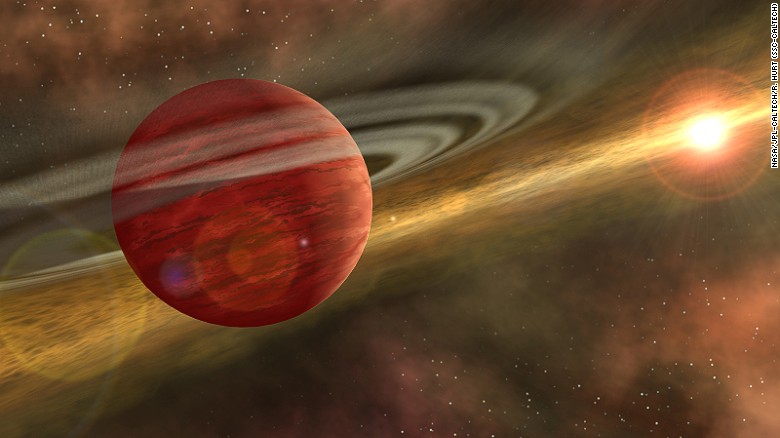
Photos: Weird and wonderful exoplanets
Dwarfing even Jupiter – HD-106906b is a gaseous planet 11 times more massive than Jupiter. The planet is believed to have formed in the center of its solar system, before being sent flying out to the edges of the region by a violent gravitational event.
Hide Caption
1 of 10

Photos: Weird and wonderful exoplanets
Scorched world – Kepler-10b orbits at a distance more than 20 times closer to its star than Mercury is to our own sun. Daytime temperatures exceed 1,300 degrees Celsius (2,500 degrees Fahrenheit), which is hotter than lava flows on Earth.
Hide Caption
2 of 10

Photos: Weird and wonderful exoplanets
Real-life Tatooine – This Jupiter-like planet in the HD-188753 system 149 light-years from Earth has three suns. The main star is similar in mass to our own Sun. The system has been compared to Luke Skywalker's home planet Tatooine in "Star Wars."
Hide Caption
3 of 10

Photos: Weird and wonderful exoplanets
Longest year in the universe – Kepler-421b is a Uranus-sized transiting exoplanet with the longest known year, as it circles its star once every 704 days. The planet orbits an orange, K-type star that is cooler and dimmer than our Sun and is located about 1,000 light-years from Earth in the constellation Lyra.
Hide Caption
4 of 10

Photos: Weird and wonderful exoplanets
Crowded neighborhood – Astronomers discovered two planets less than three times the size of Earth orbiting sun-like stars in a crowded stellar cluster approximately 3,000 light-years from Earth in the constellation Cygnus.
Hide Caption
5 of 10

Photos: Weird and wonderful exoplanets
Red dwarfed – This artist's conception shows a hypothetical planet with two moons orbiting in the habitable zone of a red dwarf star. The majority of the sun's closest stellar neighbors are red dwarfs.
Hide Caption
6 of 10

Photos: Weird and wonderful exoplanets
First second-Earth – Kepler-186f was the first validated Earth-sized planet to be found orbiting a distant star in the habitable zone. This zone a range of distance from a star where liquid water might pool on the planet's surface.
Hide Caption
7 of 10

Photos: Weird and wonderful exoplanets
Super Venus – Kepler-69c is a super-Earth-size planet similar to Venus. The planet is found in the habitable zone of a star like our sun, located approximately 2,700 light years from Earth in the constellation Cygnus.
Hide Caption
8 of 10

Photos: Weird and wonderful exoplanets
Tiny worlds – The Kepler-444 system formed when the Milky Way was just two billion years old. The tightly packed system is home to five planets that range in size, the smallest is comparable to the size of Mercury and the largest to Venus, orbiting their sun in less than 10 days.
Hide Caption
9 of 10

Photos: Weird and wonderful exoplanets
Our older cousin – This artistic concept image compares Earth (left) to Kepler-452b, which is about 60 percent larger. Both planets orbit a G2-type star of about the same temperature; however, the star hosting Kepler-452b is 6 billion years old -- 1.5 billion years older than our sun.
Hide Caption
10 of 10

Photos: Weird and wonderful exoplanets
Dwarfing even Jupiter – HD-106906b is a gaseous planet 11 times more massive than Jupiter. The planet is believed to have formed in the center of its solar system, before being sent flying out to the edges of the region by a violent gravitational event.
Hide Caption
1 of 10

Photos: Weird and wonderful exoplanets
Scorched world – Kepler-10b orbits at a distance more than 20 times closer to its star than Mercury is to our own sun. Daytime temperatures exceed 1,300 degrees Celsius (2,500 degrees Fahrenheit), which is hotter than lava flows on Earth.
Hide Caption
2 of 10

Photos: Weird and wonderful exoplanets
Real-life Tatooine – This Jupiter-like planet in the HD-188753 system 149 light-years from Earth has three suns. The main star is similar in mass to our own Sun. The system has been compared to Luke Skywalker's home planet Tatooine in "Star Wars."
Hide Caption
3 of 10

Photos: Weird and wonderful exoplanets
Longest year in the universe – Kepler-421b is a Uranus-sized transiting exoplanet with the longest known year, as it circles its star once every 704 days. The planet orbits an orange, K-type star that is cooler and dimmer than our Sun and is located about 1,000 light-years from Earth in the constellation Lyra.
Hide Caption
4 of 10

Photos: Weird and wonderful exoplanets
Crowded neighborhood – Astronomers discovered two planets less than three times the size of Earth orbiting sun-like stars in a crowded stellar cluster approximately 3,000 light-years from Earth in the constellation Cygnus.
Hide Caption
5 of 10
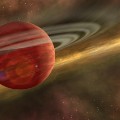

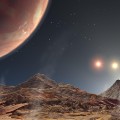

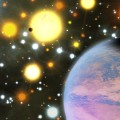
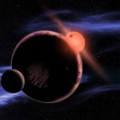
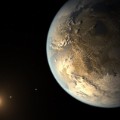
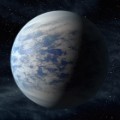 Since the launch of NASA's planet-hunting space probe Kepler, there have been more than 3,000 exoplanets confirmed in our universe. Exoplanets are important for our search in finding habitable planets because they could possibly harbor life.
Stars are born in clusters, and during that time if they pass by one another they can "steal" a planet or two. Astronomers believe that was probably the case with Planet Nine.
"Planet [Nine] may very well have been 'shoved' by other planets, and when it ended up in an orbit that was too wide around its own star, our sun may have taken the opportunity to steal and capture Planet Nine from its original star," Mustill said.
It's an extraordinary hypothesis, except there's still debate over whether such a world even exists.
"While the existence of Planet [Nine] remains unproven, we consider capture from one of the sun's young brethren a plausible route to explain such an object's orbit," the report stated.
Researchers at the California Institute of Technology announced they found evidence that Planet Nine is lying in our outer solar system, and that the world is a true planet, not a dwarf planet like Pluto.
Supposedly, Planet Nine orbits 20 times farther from the sun than Neptune, which means it may take the world 10,000 to 20,000 Earth years to make a full orbit around our sun.
More research is needed, Mustill said. But if Planet Nine really exists, that means we may be able to visit it one day.
"This is the only exoplanet that we, realistically, would be able to reach using a space probe," he said.
Since the launch of NASA's planet-hunting space probe Kepler, there have been more than 3,000 exoplanets confirmed in our universe. Exoplanets are important for our search in finding habitable planets because they could possibly harbor life.
Stars are born in clusters, and during that time if they pass by one another they can "steal" a planet or two. Astronomers believe that was probably the case with Planet Nine.
"Planet [Nine] may very well have been 'shoved' by other planets, and when it ended up in an orbit that was too wide around its own star, our sun may have taken the opportunity to steal and capture Planet Nine from its original star," Mustill said.
It's an extraordinary hypothesis, except there's still debate over whether such a world even exists.
"While the existence of Planet [Nine] remains unproven, we consider capture from one of the sun's young brethren a plausible route to explain such an object's orbit," the report stated.
Researchers at the California Institute of Technology announced they found evidence that Planet Nine is lying in our outer solar system, and that the world is a true planet, not a dwarf planet like Pluto.
Supposedly, Planet Nine orbits 20 times farther from the sun than Neptune, which means it may take the world 10,000 to 20,000 Earth years to make a full orbit around our sun.
More research is needed, Mustill said. But if Planet Nine really exists, that means we may be able to visit it one day.
"This is the only exoplanet that we, realistically, would be able to reach using a space probe," he said.
(CNN)We may be a step closer to figuring out the origins of Planet Nine, a mysterious world lurking at the edge of our solar system.
If the scientists are right, that would make Planet Nine the first exoplanet to be discovered in our solar system, according to astronomers at Lund University in Sweden. They came to this exoplanet theory based on computer models. It's likely that while our sun was still young, about 4.5 billion years ago, it stole Planet Nine from another star — classic interstellar drama.
"It is almost ironic that while astronomers often find exoplanets hundreds of light years away in other solar systems, there's probably one hiding in our own backyard," Alexander Mustill, astronomer at Lund University, said in a statement.

Photos: Weird and wonderful exoplanets
Red dwarfed – This artist's conception shows a hypothetical planet with two moons orbiting in the habitable zone of a red dwarf star. The majority of the sun's closest stellar neighbors are red dwarfs.
Hide Caption
6 of 10
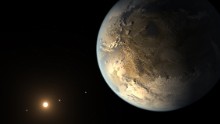
Photos: Weird and wonderful exoplanets
First second-Earth – Kepler-186f was the first validated Earth-sized planet to be found orbiting a distant star in the habitable zone. This zone a range of distance from a star where liquid water might pool on the planet's surface.
Hide Caption
7 of 10
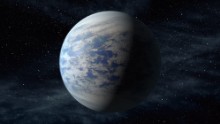
Photos: Weird and wonderful exoplanets
Super Venus – Kepler-69c is a super-Earth-size planet similar to Venus. The planet is found in the habitable zone of a star like our sun, located approximately 2,700 light years from Earth in the constellation Cygnus.
Hide Caption
8 of 10
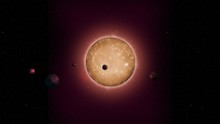
Photos: Weird and wonderful exoplanets
Tiny worlds – The Kepler-444 system formed when the Milky Way was just two billion years old. The tightly packed system is home to five planets that range in size, the smallest is comparable to the size of Mercury and the largest to Venus, orbiting their sun in less than 10 days.
Hide Caption
9 of 10
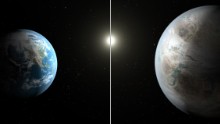
Photos: Weird and wonderful exoplanets
Our older cousin – This artistic concept image compares Earth (left) to Kepler-452b, which is about 60 percent larger. Both planets orbit a G2-type star of about the same temperature; however, the star hosting Kepler-452b is 6 billion years old -- 1.5 billion years older than our sun.
Hide Caption
10 of 10
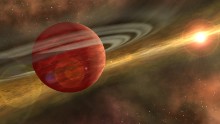
Photos: Weird and wonderful exoplanets
Dwarfing even Jupiter – HD-106906b is a gaseous planet 11 times more massive than Jupiter. The planet is believed to have formed in the center of its solar system, before being sent flying out to the edges of the region by a violent gravitational event.
Hide Caption
1 of 10
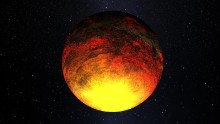
Photos: Weird and wonderful exoplanets
Scorched world – Kepler-10b orbits at a distance more than 20 times closer to its star than Mercury is to our own sun. Daytime temperatures exceed 1,300 degrees Celsius (2,500 degrees Fahrenheit), which is hotter than lava flows on Earth.
Hide Caption
2 of 10
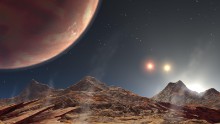
Photos: Weird and wonderful exoplanets
Real-life Tatooine – This Jupiter-like planet in the HD-188753 system 149 light-years from Earth has three suns. The main star is similar in mass to our own Sun. The system has been compared to Luke Skywalker's home planet Tatooine in "Star Wars."
Hide Caption
3 of 10
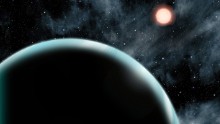
Photos: Weird and wonderful exoplanets
Longest year in the universe – Kepler-421b is a Uranus-sized transiting exoplanet with the longest known year, as it circles its star once every 704 days. The planet orbits an orange, K-type star that is cooler and dimmer than our Sun and is located about 1,000 light-years from Earth in the constellation Lyra.
Hide Caption
4 of 10
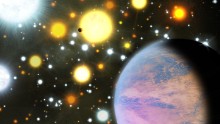
Photos: Weird and wonderful exoplanets
Crowded neighborhood – Astronomers discovered two planets less than three times the size of Earth orbiting sun-like stars in a crowded stellar cluster approximately 3,000 light-years from Earth in the constellation Cygnus.
Hide Caption
5 of 10

Photos: Weird and wonderful exoplanets
Red dwarfed – This artist's conception shows a hypothetical planet with two moons orbiting in the habitable zone of a red dwarf star. The majority of the sun's closest stellar neighbors are red dwarfs.
Hide Caption
6 of 10

Photos: Weird and wonderful exoplanets
First second-Earth – Kepler-186f was the first validated Earth-sized planet to be found orbiting a distant star in the habitable zone. This zone a range of distance from a star where liquid water might pool on the planet's surface.
Hide Caption
7 of 10

Photos: Weird and wonderful exoplanets
Super Venus – Kepler-69c is a super-Earth-size planet similar to Venus. The planet is found in the habitable zone of a star like our sun, located approximately 2,700 light years from Earth in the constellation Cygnus.
Hide Caption
8 of 10

Photos: Weird and wonderful exoplanets
Tiny worlds – The Kepler-444 system formed when the Milky Way was just two billion years old. The tightly packed system is home to five planets that range in size, the smallest is comparable to the size of Mercury and the largest to Venus, orbiting their sun in less than 10 days.
Hide Caption
9 of 10

Photos: Weird and wonderful exoplanets
Our older cousin – This artistic concept image compares Earth (left) to Kepler-452b, which is about 60 percent larger. Both planets orbit a G2-type star of about the same temperature; however, the star hosting Kepler-452b is 6 billion years old -- 1.5 billion years older than our sun.
Hide Caption
10 of 10

Photos: Weird and wonderful exoplanets
Dwarfing even Jupiter – HD-106906b is a gaseous planet 11 times more massive than Jupiter. The planet is believed to have formed in the center of its solar system, before being sent flying out to the edges of the region by a violent gravitational event.
Hide Caption
1 of 10

Photos: Weird and wonderful exoplanets
Scorched world – Kepler-10b orbits at a distance more than 20 times closer to its star than Mercury is to our own sun. Daytime temperatures exceed 1,300 degrees Celsius (2,500 degrees Fahrenheit), which is hotter than lava flows on Earth.
Hide Caption
2 of 10

Photos: Weird and wonderful exoplanets
Real-life Tatooine – This Jupiter-like planet in the HD-188753 system 149 light-years from Earth has three suns. The main star is similar in mass to our own Sun. The system has been compared to Luke Skywalker's home planet Tatooine in "Star Wars."
Hide Caption
3 of 10

Photos: Weird and wonderful exoplanets
Longest year in the universe – Kepler-421b is a Uranus-sized transiting exoplanet with the longest known year, as it circles its star once every 704 days. The planet orbits an orange, K-type star that is cooler and dimmer than our Sun and is located about 1,000 light-years from Earth in the constellation Lyra.
Hide Caption
4 of 10

Photos: Weird and wonderful exoplanets
Crowded neighborhood – Astronomers discovered two planets less than three times the size of Earth orbiting sun-like stars in a crowded stellar cluster approximately 3,000 light-years from Earth in the constellation Cygnus.
Hide Caption
5 of 10








Since the launch of NASA's planet-hunting space probe Kepler, there have been more than 3,000 exoplanets confirmed in our universe. Exoplanets are important for our search in finding habitable planets because they could possibly harbor life.
Stars are born in clusters, and during that time if they pass by one another they can "steal" a planet or two. Astronomers believe that was probably the case with Planet Nine.
"Planet [Nine] may very well have been 'shoved' by other planets, and when it ended up in an orbit that was too wide around its own star, our sun may have taken the opportunity to steal and capture Planet Nine from its original star," Mustill said.
It's an extraordinary hypothesis, except there's still debate over whether such a world even exists.
"While the existence of Planet [Nine] remains unproven, we consider capture from one of the sun's young brethren a plausible route to explain such an object's orbit," the report stated.
Researchers at the California Institute of Technology announced they found evidence that Planet Nine is lying in our outer solar system, and that the world is a true planet, not a dwarf planet like Pluto.
Supposedly, Planet Nine orbits 20 times farther from the sun than Neptune, which means it may take the world 10,000 to 20,000 Earth years to make a full orbit around our sun.
More research is needed, Mustill said. But if Planet Nine really exists, that means we may be able to visit it one day.
"This is the only exoplanet that we, realistically, would be able to reach using a space probe," he said.
Related Posts :
- Back to Home »
- News Internasional »
- Sun may have stolen mysterious ninth planet, scientists say

















